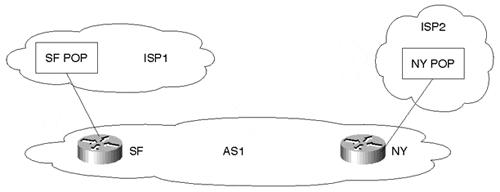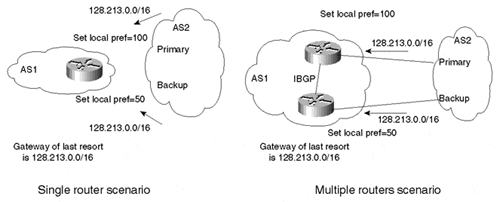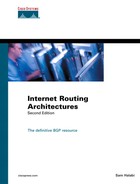Redundancy
Although corporations and providers would prefer uninterrupted connectivity, connectivity problems occur for one reason or another from time to time. Connectivity is not the responsibility of one entity. A router's connection to the Internet involves the router, the CSU/DSU, power, cabling, physical access line, and numerous administrators—each with influence over different parts of the connection. At any time, human error, software errors, physical errors, or adverse unforeseen conditions (such as bad weather or power outages) can jeopardize connectivity.
For all these reasons, redundancy is generally desirable. Finding the correct balance between redundancy and symmetry, however, is critical. Redundancy and symmetry can be conflicting design goals: The more redundancy a network has, the more unpredictable the traffic entrance and exit points are. If a customer has multiple connections—one to a Point Of Presence (POP) in San Francisco and another to a POP in New York—traffic leaving San Francisco might come back from New York. Adding a third connection to a POP in Dallas makes connectivity even more reliable, but it also makes traffic symmetry more challenging. Network administrators must consider these trade-offs in implementing routing policies.
Geographical Restrictions Pressure
In addition to the reliability motivation, companies might feel geographical pressure to implement redundancy. Many contemporary companies are national, international, or multinational in nature. For them, the autonomous system is a logical entity that spans different physical locations. A corporation with an AS that spans several geographical points can take service from a single provider or from different providers in different regions. In Figure 7-1, the San Francisco office of AS1 connects to the San Francisco POP of ISP1, and the New York office connects to the New York POP of ISP2. In this environment, traffic can take a shorter path to reach a destination by traveling via the geographically adjacent POP.
Figure 7-1. Geographically Based Multihoming Situation

Because redundancy refers to the existence of alternate routes to and from a network, this translates into additional routing information that needs to be kept in the routing tables. To avoid the extra routing overhead, default routing becomes an alternative practical tool. Default routing can provide you with backup routes in case primary connections fail. The next section attempts to define the different aspects of default routing and how it can be applied to achieve simple routing scenarios.
Setting Default Routes
Following defaults is a powerful technique in minimizing the number of routes a router has to learn and providing networks with redundancy in the event of failures and connectivity interruptions. Cisco calls the default path the gateway of last resort. It is important to understand how default routing works. Although it makes life easier when configured correctly, life is more difficult when routing is configured incorrectly.
By definition, a default route is a route in the IP forwarding table that is used if a routing entry for a destination does not exist. In other words, a default route is a last resort in case specific route information for a destination is unknown.
Dynamically Learned Defaults
The universally known default route is usually represented by the network mask combination 0.0.0.0/0.0.0.0 (also represented as 0/0). This route can be exchanged as a dynamic advertisement between routers. Any system advertising this route represents itself as a gateway of last resort for other systems. Figure 7-2 illustrates such an advertisement.
Figure 7-2. Dynamic Default Advertisement

Dynamic defaults (0/0) can be learned via BGP or IGP, depending on what protocol is running between two domains. For redundancy purposes and to accommodate potential failures, you should receive defaults from multiple sources. In the context of BGP, the local preference can be set for the default to give a degree of preference over which default is primary and which is backup. If one default goes away, the other will take its place.
In the left instance of Figure 7-2, a single router connects AS1 to AS2 via two connections. If AS1 chooses to accept as few routes as possible from AS2, AS1 can accept only the 0/0 default route. In this example, AS1 learns 0/0 from two links and gives preference by setting the local preference to 100 on the primary link and 50 (or any number smaller than 100) on the backup link. During normal operation, this would set the gateway of last resort to 1.1.1.1.
In the multiple routers scenario (the right instance of Figure 7-2), the same behavior can be achieved with multiple routers as long as IBGP is running inside the AS. Local preference, which is exchanged between IBGP routers, determines the primary and backup links.
Tip
See the section “Dynamically Learned Defaults” in Chapter 12, “Configuring Effective Internet Routing Policies”, on page 365.
Statically Set Defaults
Many operators choose to filter dynamically learned defaults to avoid situations in which traffic ends up where it is not supposed to be. Thus, it is also possible for an AS to statically set its own defaults by setting its own 0/0 route. Statically set defaults provide more control over routing behaviors because the operator has the option of defining his last resort rather than having it forced on him by some outside entity.
Tip
See the section “Statically Set Defaults” in Chapter 12 on page 367.
An operator can statically set the default route 0/0 to point to the following:
-
The IP address of the next-hop gateway
-
A specific router interface
-
A network number
Figure 7-3 illustrates the first two possibilities. On the left, a router statically points its own 0/0 default toward the IP address 1.1.1.1. On the right, the same router points its default toward an Ethernet interface. In the latter of the two approaches, further processing is needed to figure out to whom on the segment the traffic should be sent. Such processing usually involves sending Address Resolution Protocol (ARP)[1] packets to identify the physical address of the next-hop router.
Figure 7-3. Statically Set Defaults

A system can also set its default based on a network number it learns from another system. In Figure 7-4, AS1 dynamically learns route 192.213.0.0/16 from AS2. If AS1 points its default to 192.213.0.0/16, that network automatically becomes the gateway of last resort. This approach uses recursive route lookup to find the IP address of the next-hop gateway. In this example, the recursive lookup determines that 192.213.0.0/16 was learned via the next hop 1.1.1.1, and traffic would be directed accordingly.
Figure 7-4. Pointing Default Toward a Network Number

It is important for defaults to disappear dynamically if what they point to disappears. Cisco lets a statically defined default follow the existence of the entity to which it is pointing. For example, if the default is pointing to a network number and that network can no longer be reached (it does not show in the IP routing table), the default will also disappear from the IP routing table. This behavior is needed in situations in which multiple defaults exist. One default can be used as primary and others as a backup in case the primary default is no longer valid.
Default networks should be selected as far upstream (close to the Internet) as possible so that they are more representative of the whole link toward the NAP or other service provider interconnections rather than a portion. This is important if the AS you are connected to has a single connection toward the NAP. In Figure 7-4, AS1 can set the default toward its provider, AS2, by pointing to prefix 128.213.11.0/24 or the supernet 192.213.0.0/16. Pointing the default to 128.213.11.0/24 makes it dependent on the stability of a portion of the link (AS1 to AS2) and not the whole link (AS1 to AS3) toward the NAP. If the link between AS2 and AS3 goes down, AS1 will still send traffic toward AS2 rather than directing it to some other default (assuming that AS1 has other providers). A better default choice would be the supernet, 192.213.0.0/16, because its existence is more representative of the whole link toward the NAP and is no longer dependent on any intervening links.
Selected default networks should not be specific subnets. A subnet that is flip-flopping might cause your default to come and go constantly. It is much better to point the default to a major aggregate or supernet that reflects the stability of a whole provider rather than a particular link.
Multiple static defaults can be used at the same time. One way to set multiple static defaults is to point to multiple networks (using aggregates if possible for stability reasons) and establish a degree of preference by using the local preference BGP attribute. This would apply to a single router connected to the provider via multiple connections or to multiple routers running IBGP inside the AS. Both scenarios are illustrated in Figure 7-5. These are similar to the scenarios you saw in Figure 7-4. The only difference is that the customer sets its own default rather than relying on the provider to send the 0/0 default route. In this example, the customer chooses 128.213.0.0/16 with the local preference of 100 via the upper link. The lower link is used as a backup, based on a local preference of 50 for the default in case of failure in the primary link.
Figure 7-5. Statically Pointing to Multiple Network Defaults

Another way of setting defaults statically involves using the Cisco distance parameter (as described in Table 6-1 in Chapter 6, "Tuning BGP Capabilities") to establish a degree of preference. Because the distance parameter is not exchanged between routers, this would work only in the case of one router connected via multiple connections.
If two static default entries are defined with different distances, the default with the lower distance wins. If the better default goes away, the second default becomes available. If both defaults have the same distance, traffic will be balanced between the two default paths using mechanisms provided by the underlying switching mode utilized.
Figure 7-6 illustrates the use of the distance parameter in setting multiple defaults. AS1 is connected to AS2 via two links and sets its own defaults toward AS2. AS1 uses one link as primary by giving the static default a distance of 50, lower than the distance of 60 given to the backup link. In case of failure in the primary link, traffic will shift toward the backup.
Figure 7-6. Static Defaults Pointing to Multiple Connections

Understand that if a route is associated with an interface, the interface must be unavailable before the route becomes invalid. For example, Cisco HDLC by default exchanges keepalive messages across the connection. If the keepalives are not received within a specified interval, the interface protocol connection is dropped. This results in the route's being removed. On the other hand, a Frame Relay or ATM virtual circuit doesn't exchange keepalive messages with the remote router. This means that if the virtual circuit fails, the interface will still be active, as will the associated route.
